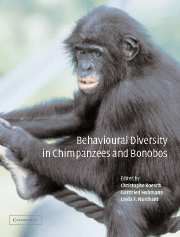Book contents
- Frontmatter
- Contents
- List of contributors
- Preface
- Behavioural Diversity in Pan
- PART I BEHAVIOURAL FLEXIBILITY
- PART II SOCIAL RELATIONS
- INTRODUCTION
- 6 Factors influencing fission–fusion grouping in chimpanzees in the Taï National Park, Côte d'Ivoire
- 7 Ecological and social correlates of chimpanzee party size and composition
- 8 Agonistic relations among Kanyawara chimpanzees
- 9 Relationships of male chimpanzees in the Budongo Forest, Uganda
- 10 Dynamics in social organization of bonobos (Pan paniscus)
- PART III FEMALE STRATEGIES
- PART IV HUNTING AND FOOD SHARING
- PART V GENETIC DIVERSITY
- Index
6 - Factors influencing fission–fusion grouping in chimpanzees in the Taï National Park, Côte d'Ivoire
Published online by Cambridge University Press: 08 February 2010
- Frontmatter
- Contents
- List of contributors
- Preface
- Behavioural Diversity in Pan
- PART I BEHAVIOURAL FLEXIBILITY
- PART II SOCIAL RELATIONS
- INTRODUCTION
- 6 Factors influencing fission–fusion grouping in chimpanzees in the Taï National Park, Côte d'Ivoire
- 7 Ecological and social correlates of chimpanzee party size and composition
- 8 Agonistic relations among Kanyawara chimpanzees
- 9 Relationships of male chimpanzees in the Budongo Forest, Uganda
- 10 Dynamics in social organization of bonobos (Pan paniscus)
- PART III FEMALE STRATEGIES
- PART IV HUNTING AND FOOD SHARING
- PART V GENETIC DIVERSITY
- Index
Summary
INTRODUCTION
The relationship between primate social group size and ecological factors has been a focal point of numerous theoretical and empirical research efforts (van Schaik & van Hooff 1983; Terborgh & Janson 1986; Chapman et al. 1995; Janson & Goldsmith 1995; Chapman & Chapman 2000). An increase in group size may confer benefits of increased protection from predation or infanticide, and/or increased effectiveness in intergroup competition (Wrangham 1980; van Schaik & van Hooff 1983; Sterck et al. 1997; Boesch & Boesch-Achermann 2000). Furthermore, individuals may prefer to associate with others to build coalitions (Boesch & Boesch-Achermann 2000), or to facilitate the socialization of offspring (Williams et al., Chapter 14).14). However, the benefits of sociality come at the cost of an increase in intragroup foraging competition and an increase in traveling between food patches (Chapman et al. 1995; Janson & Goldsmith 1995). Consequently, the ecological constraints model predicts that the size of primate social groups should have an upper limit that is determined by the abundance and distribution of food (Chapman & Chapman 2000).
Chimpanzees and other primates that live in fission–fusion social organizations have been the focus of efforts to understand better how group size is constrained by ecological factors. In these societies, individuals form parties that change in size and composition many times a day (Goodall 1986; Boesch 1996). Substantial empirical evidence suggests that party sizes are correlated with patch size (Symington 1988; Strier 1989; de Moraes & de Carvalho 1998; Newton-Fisher et al. 2000), and that seasonal variations in party sizes are related to seasonal fluctuations in the habitat-wide abundance and distribution of food (Chapman et al. 1995).
- Type
- Chapter
- Information
- Behavioural Diversity in Chimpanzees and Bonobos , pp. 90 - 101Publisher: Cambridge University PressPrint publication year: 2002
- 83
- Cited by

